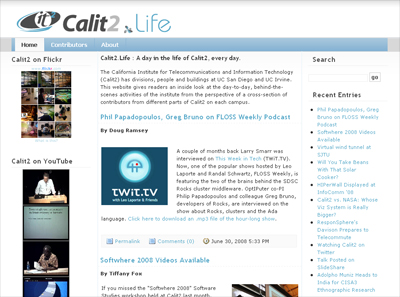A Day in the Life of Calit2: New Blog Is Experiment in Institutional Lifecasting
San Diego, CA, July 1, 2008 -- The California Institute for Telecommunications and Information Technology (Calit2) today launched a new blog as an experiment in institutional lifecasting. Called Calit2.Life, the group blog provides readers with an ongoing day-in-the-life account of the institute's inner workings.
|
Lifecasting leverages the use of digital media to tell the world what's going on in a person's life as it is happening. Lifecasters have typically used continuous video streams, but Calit2.Life takes the basic concept and applies it to text, images and video of behind-the-scenes activities at Calit2. The new site is a venue for comments, notes, updates, insights and observations about everyday events in the life of Calit2 at UC Irvine and UC San Diego – capturing the institute’s previously unwritten history with stories that might not qualify yet for a long-form news release or feature article on the main Calit2 Web site.
“The original Web site will continue to be the ‘official’ portal into Calit2, but in the age of social networking, we also need more informal ways to secure a larger share of the global attention stream,” said Larry Smarr, director of Calit2, who also holds the Harry E. Gruber Chair in the Computer Science and Engineering department of the UCSD Jacobs School of Engineering. “We need to offer a different type of web experience that allows many more voices to be heard than a traditional Web site can offer, and our beta testing of Calit2.Life tells us that this decentralized authorship of content has tremendous potential.”
“The institute has grown by leaps and bounds in the past eight years,” added Ramesh Rao, director of Calit2’s UCSD division, who holds the Qualcomm Endowed Chair in Telecommunication and Information Technologies in the Jacobs School ’s Electrical and Computer Engineering department. “With so many people working for, or affiliated with, Calit2, it is difficult to keep track of all the exciting work being done at the institute, so we are hoping that Calit2.Life will become an important internal forum for exchanging ideas and information.”
The main Calit2 Web site will remain Calit2’s Web site of record, providing news, features and information about Calit2 services and resources, including information on how faculty members, students, staff and industry partners can interact with the institute.
Calit2.Life is structured as a group blog. The initial roster of contributors includes roughly one dozen senior Calit2 personnel, communications staff and directors of affiliated research centers. Over time, more contributors will be added to ensure that Calit2.Life remains representative of people and activities on both campuses.
“There is a lot of activity at UC Irvine that is not captured by the traditional web presence of Calit2, and the same is true for UCSD,” said G.P. Li, director of the UCI division of Calit2 and professor of Electrical Engineering and Computer Science as well as Biomedical Engineering in The Henry Samueli School of Engineering at UCI. “Calit2.Life has the potential to bring the two divisions closer together and we hope that faculty and students will use it as a tool for seeding collaborations with counterparts across campus or between campuses.”
Designed from the start to be easy to use, Calit2.Life accepts postings in a variety of formats, including texting from a web-enabled cell phone, emailing, or logging into the site's content management system from a laptop or desktop. Readers are encouraged to leave comments in response to posts that interest them.
“Calit2.Life leverages the convergence of micro-blogging and posting from mobile devices,” explained Jerry Sheehan, manager of government relations for the UCSD division of Calit2, who oversaw development of the site by staff programmer Arindam Ganguly and webmaster Cristian Horta. “Contributors need to be able to author and post items anywhere and anytime, so we embraced the killer app of email as a key way to get content on the web.”
Sheehan and Ganguly previously developed Calit2’s Research Intelligence portal , which now has 240 registered users, 80 of them faculty. The portal was developed to provide a better data-driven understanding of research at Calit2, and it is built on open data using a variety of natural-language processing algorithms to distill meaning. The RI portal allows users to browse the expertise of Calit2-affiliated researchers, create teams and identify funding opportunities.
Like Research Intelligence, Calit2.Life uses open-source solutions and integrates Web 2.0 tools that make it easier to track the day-to-day activities of Calit2 as represented across the Internet. These tools include applets that crawl Flickr for images related to Calit2, videos related to Calit2 that are available through YouTube, and Powerpoint presentations through SlideShare. Future tools will make it possible to track the whereabouts of willing contributors to capture the GPS coordinates from the mobile device used to create a post, and for graphic display in Google Earth.
The new Web site is part of a wider initiative to raise Calit2’s visibility in the small but fast-growing social networking arena. Dubbed Calit2.Social, the initiative is an effort to experiment with ‘social’ Web 2.0 technologies, including social bookmarking. So far, more than 1,200 articles from the main Calit2 Web site have been ‘socialized’ to bookmarking services such as del.icio.us, ma.gnolia, and 2collab.
Related Links
Calit2.Life
Research Intelligence
de.licio.us
ma.gnolia
2collab
Media Contacts
Doug Ramsey, 858-822-5825, dramsey@ucsd.edu

